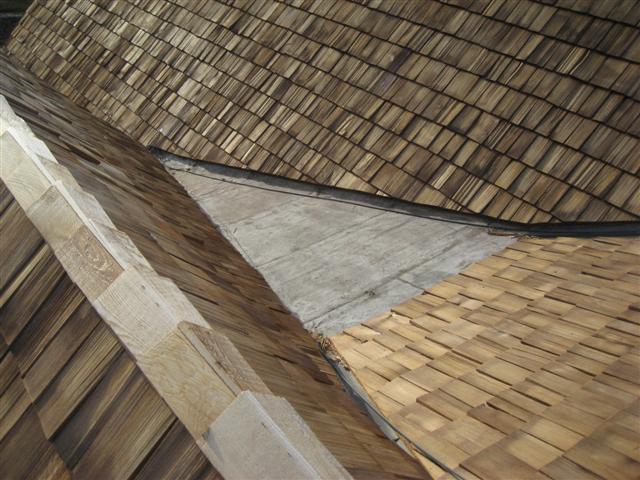This roof is coming up on its first winter. Any comments about how these areas were handled?





This roof is coming up on its first winter. Any comments about how these areas were handled?





Looks like they’ve made some excellent funnels to shove water under some of the shakes.
My client says the roofer told them that the staples for attaching shingles over the membrane in the areas without shingles would cause leaks in the membrane. He told them this is an acceptable practice. There are also some flashing issues which should be corrected.
Another roofer tells my client that that the whole roof needs to be replaced saying it won’t last the snowy winter.
First pic is real questionable. Not sure about the others. Just not enough detail for me to tell.
See this
http://www.cedarbureau.org/installation/roof_manual/pdfs/Roof-manual-p10.pdf
for the whole thing
In the first picture why would the flashing go under the membrane???..warning…Danger Will Robinson…
Are you saying I wasn’t seeing things???![]()
Good catch
You should win some sort of prize.
that’s the way it looks to Me frank…bass akwards is my guess…
OK Another question. On the back and sides of the chimney. Is the membrane cut flush with the chimney where it penetrates the roof???
sorry can’t help you with that one from that picture Frank…
On the back and sides of the chimney it is uncertain where the membrane ends. The finish masonry was applied over the membrane.
On another chimney the finish masonry was applied over the shakes. See photo #2159.
Back to the exposed membrane on steep slopes without shakes. Is there an acceptable argument for not putting shakes on the areas with adequate slope? Is there a more acceptable procedure over the areas with less slope? See photos in original post.
Some of the exposed areas are visible from the ground. See photos #2338, 2387.



“Back to the exposed membrane on steep slopes without shakes. Is there an acceptable argument for not putting shakes on the areas with adequate slope? Is there a more acceptable procedure over the areas with less slope? See photos in original post.” The membrane was used to open up some areas that shakes would have interferred with the water flow. The lowest points of those areas don’t appear to be open enough. Personally, I would have preferred 20 oz. copper, or lead coated copper, flat-locked and sweated together. Not totally familiar with SBS and APP membranes, but only consider them to have a 10 year life. Shakes are ‘supposed’ to last 40 years. Doesn’t make sense.
As for the other chimney. Where is the water to exit at eave? Looks like it drains into/behind the stone veneer.
Lack of kickout diverter.
On the other chimney, since the finish masonry was set above the shakes, kick-outs were formed with the mortar.
Some kick-outs were absent at other areas.
The other roofer is correct. At least some of that work needs to be redone. It is no disgrace to do rework, well not much, and better than the consequences. In my youth, we would have used painted metal valley flashing and laid the shakes over, keeping the nails high, as long as there was over 4:12 slope.
If there are areas with lower slope, maybe torch-on membrane. But that is a design screwup, such as where the dormers meet. Chimney in the valley, etc. The architect should take some of the blame, IMO. Too late now, but he or she should be chastised. :mrgreen:
John Kogel
www.allsafehome.ca
Kick-outs were formed with the mortar.
That ought to work real well until it rains.
You will not get 40 years out of a wood shingle roof. Lucky to get 18. Idaho has worse winters than here in Kansas. You may get 15. Think snow when you look at these areas also.
Those are split shakes, Gary, tougher by far than sawn shingles. Kept clear of moss and leaves, in dry country Utah, they should be good for 30-40 yrs. Unless there are poor grade shakes in the batch :mad: and good cedar is getting rare even here where it used to grow everywhere. We sold it all.
John Kogel
www.allsafehome.ca
I know this is a few days old but here are some examples of how I have handled this same issue
Mark